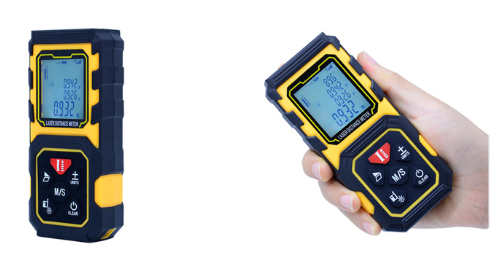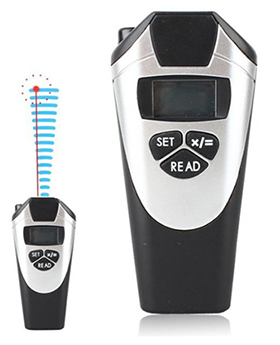Laser distance measurement and radio detection radars follow the same operating principle: Emit the laser towards the target object, measure the time for the laser to travel back and forth, and calculate the distance by multiplying the recorded time and the velocity of light. The laser is characterized by such merits as high directivity, monochromaticity, and power, which play critical roles in measuring a long distance, judging the target object's direction, raising the reception system's SNR, and guaranteeing the measurement accuracy. With these features, laser distance meters receive growing attention. Laser radars, which have been developed based on laser distance meters, measure not only distances but also the target object's direction, movement velocity, and acceleration. By far, laser radars have been successfully applied to measuring distances and tracking man-made satellites. For instance, the measurement range of ruby lasers is 500-2,000km, with a deviation of only a few meters. Currently, lasers made of rubies, neodymium glass, carbon dioxide, and gallium arsenide are used as light sources for laser distance meters.

Ultrasonic distance measures observe the following operating principle: If the ultrasonic wave travels at a fixed velocity in air, the meter will measure the time for the emitted sound wave to be reflected after hitting the obstacle back and calculate the distance between the emitting point to the obstacle between the time of transmittance and reception. The ultrasonic distance measure consists of an ultrasonic generating circuit, an ultrasonic receiver/ amplifier circuit, and a counting & display circuit. Although the ultrasonic sensor is often applied to testing remote objects, it is not an optical device and remains unaffected by color changes. Despite this, ultrasonic sensors measure the distance according to the velocity of sound and have inherent drawbacks, making them unsuitable for the following scenarios:
- The target object is not perpendicular to the sensor's transducer. It is because the declination between the target object of ultrasonic testing and the sensor should be within 10°.
- Light beams have a small diameter. It is because ultrasonic waves generally have a diameter of 0.76m after leaving the sensor by 2m.
- Scenarios for calibrating the position of facula.
- Windy scenarios.
- Vacuum scenarios.
- Scenarios with a high-temperature gradient that causes variations in the sound velocity.
- Scenarios for fast responses.
 Regarding the measurement range, ultrasonic distance measures measure objects within 80m. The 18m ultrasonic distance meter on tool.com is a typical product. Hand-held laser distance meters measure objects within 200m at maximum, laser rangefinders measure objects located hundreds of meters away or farther (the measurement precision of laser ranging telescopes varies from decades of centimeters to 1m).
Regarding the measurement range, ultrasonic distance measures measure objects within 80m. The 18m ultrasonic distance meter on tool.com is a typical product. Hand-held laser distance meters measure objects within 200m at maximum, laser rangefinders measure objects located hundreds of meters away or farther (the measurement precision of laser ranging telescopes varies from decades of centimeters to 1m).
Regarding measuring accuracy, ultrasonic distance measures and laser distance meters are precise on the centimeter and the millimeter levels, respectively.
Ultrasonic distance meters report errors easily. It is because ultrasonic distance meters emit sound waves in a fan shape. When sound waves pass many obstacles, more sound waves are reflected. It causes high interferences and makes error reporting easier. By comparison, laser distance meters only send a small ray of laser that is reflected. As long as the light beam can pass, there will be nearly no disturbance.
Ultrasonic distance measures have the merit of resistance to dirt and measure the distance in adverse conditions as long as sensors are not sealed off by dust. With this feature, ultrasonic waves are mostly applied to parking radars. On the other hand, ultrasonic distance measures have low accuracy and high costs. Laser distance meters have the merit of high precision. The downsides include safety concerns, difficulty in production, and high costs. Besides, the optical system should be kept clean. Otherwise, its measurement will be adversely affected.
The price of ultrasonic distance measures varies from decades to hundreds of yuan, while laser distance meters cost from hundreds of, thousands of, and even tens of thousands of yuan. These two categories vary widely in precision and the measured distance. Buy a 80m laser distance meter/ hand-held laser ultrasonic distance measure online now, you’ll get lower price.
Note: Infrared rangefinder are devices used for the precise ranging of objects within 1~5km through modulated infrared light. These devices follow the principle that infrared rays do not diffuse throughout transmittance because infrared light has a small refraction index when passing through other materials. For this reason, infrared rays are the primary choices for long-range distance meters. Given that it takes time for infrared rays to travel, the distance is calculated by multiplying the time for infrared rays to hit the target object, be reflected, and be received by the distance meter with the transmittance velocity. Infrared distance meters have the advantages of low prices, ease of manufacturing, and high safety. Their disadvantages include a low precision, a short ranging distance, and low directivity.

